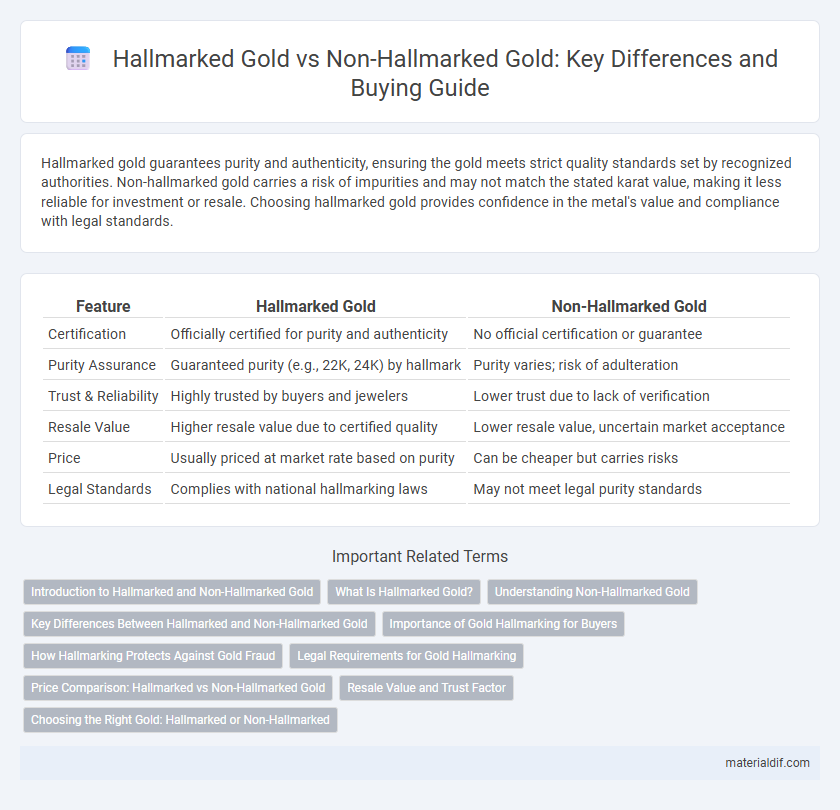Hallmarked gold guarantees purity and authenticity, ensuring the gold meets strict quality standards set by recognized authorities. Non-hallmarked gold carries a risk of impurities and may not match the stated karat value, making it less reliable for investment or resale. Choosing hallmarked gold provides confidence in the metal's value and compliance with legal standards.
Table of Comparison
| Feature | Hallmarked Gold | Non-Hallmarked Gold |
|---|---|---|
| Certification | Officially certified for purity and authenticity | No official certification or guarantee |
| Purity Assurance | Guaranteed purity (e.g., 22K, 24K) by hallmark | Purity varies; risk of adulteration |
| Trust & Reliability | Highly trusted by buyers and jewelers | Lower trust due to lack of verification |
| Resale Value | Higher resale value due to certified quality | Lower resale value, uncertain market acceptance |
| Price | Usually priced at market rate based on purity | Can be cheaper but carries risks |
| Legal Standards | Complies with national hallmarking laws | May not meet legal purity standards |
Introduction to Hallmarked and Non-Hallmarked Gold
Hallmarked gold is certified by authorized institutions confirming its purity and authenticity, ensuring buyers receive genuine gold with standardized quality. Non-hallmarked gold lacks this official certification, which can lead to uncertainty regarding its purity and value. Investing in hallmarked gold provides assurance and legal protection, while non-hallmarked gold may carry risks of adulteration or lower karat content.
What Is Hallmarked Gold?
Hallmarked gold refers to gold jewelry or items that have been officially tested and certified for purity by an authorized assay office, ensuring the metal meets specific purity standards such as 18K, 22K, or 24K. This certification is stamped or engraved on the item, providing consumers with a guarantee of authenticity and preventing fraud or misrepresentation in the gold market. Non-hallmarked gold lacks this certification, making it challenging to verify its purity and quality, which can affect resale value and consumer trust.
Understanding Non-Hallmarked Gold
Non-hallmarked gold lacks official certification, raising concerns about purity and authenticity, which can affect its market value and buyer confidence. Without standardized hallmarking, buyers risk purchasing gold with unknown alloy content or inferior quality, making it essential to verify gold purity through trusted testing methods like X-ray fluorescence (XRF) analyzers or acid tests. Understanding non-hallmarked gold requires awareness of these risks and the importance of sourcing from reputable dealers to ensure fair valuation and investment security.
Key Differences Between Hallmarked and Non-Hallmarked Gold
Hallmarked gold is certified by official agencies, ensuring its purity, weight, and quality meet legal standards, whereas non-hallmarked gold lacks such certification, increasing the risk of adulteration or inaccurate purity claims. Hallmarked gold carries a unique identification number and assay marks that guarantee buyer confidence, while non-hallmarked gold typically depends on seller reputation and informal verification. Investment in hallmarked gold offers better resale value and legal protection compared to non-hallmarked gold, which may face challenges in authenticity verification and market acceptance.
Importance of Gold Hallmarking for Buyers
Gold hallmarking guarantees the purity and authenticity of the gold, providing buyers with confidence and protection against fraud. Hallmarked gold undergoes rigorous testing and certification by authorized agencies, ensuring standardized quality and accurate karat value. Purchasing hallmarked gold reduces the risk of counterfeit products and offers legal assurance and return policies, making it a safer investment for consumers.
How Hallmarking Protects Against Gold Fraud
Hallmarked gold undergoes rigorous testing and certification by authorized assay offices, ensuring its purity and authenticity, which significantly reduces the risk of gold fraud. Non-hallmarked gold lacks standardized verification, making it susceptible to adulteration with lower purity or fake metals. The hallmark acts as a trusted guarantee for buyers, providing transparency and protection against counterfeit gold products in the market.
Legal Requirements for Gold Hallmarking
Hallmarked gold is legally certified to meet specific purity standards set by government authorities, ensuring its authenticity and consumer protection under applicable hallmarking laws. Non-hallmarked gold lacks this official certification, making it susceptible to quality disputes and potential legal issues related to fraud or misrepresentation. Regulatory frameworks mandate hallmarking for gold articles above certain weight thresholds to maintain market transparency and safeguard buyers from counterfeit or substandard products.
Price Comparison: Hallmarked vs Non-Hallmarked Gold
Hallmarked gold typically commands a higher price than non-hallmarked gold due to certified purity and quality assurance from authorized assay offices. Non-hallmarked gold may be priced lower but carries risks of impurities or inaccurate weight, affecting long-term value and resale potential. Investors and buyers often prefer hallmarked gold as a reliable asset, justifying the premium cost in the market.
Resale Value and Trust Factor
Hallmarked gold guarantees purity standards certified by authorized agencies, significantly enhancing its resale value and buyer trust compared to non-hallmarked gold, which lacks official verification and may face skepticism regarding authenticity. The hallmark ensures transparency in gold content, making hallmarked pieces more liquid and attractive in secondary markets. Conversely, non-hallmarked gold often sells at a discount due to potential doubts over its quality and higher risk of counterfeit concerns.
Choosing the Right Gold: Hallmarked or Non-Hallmarked
Hallmarked gold guarantees purity and authenticity, as it undergoes rigorous testing and certification by authorized assay offices, ensuring buyers receive genuine metal with specified karatage. Non-hallmarked gold lacks official verification, increasing the risk of impurities or alloy substitution, which may affect value and durability. Selecting hallmarked gold offers confidence in quality and resale value, making it the preferred choice for investment and jewelry purchases.
Hallmarked Gold vs Non-Hallmarked Gold Infographic

 materialdif.com
materialdif.com